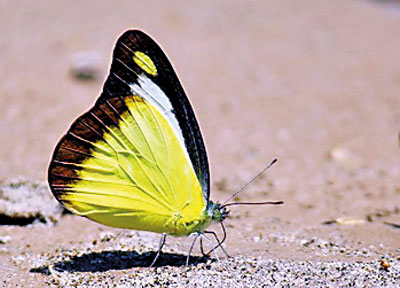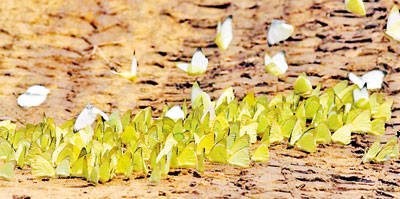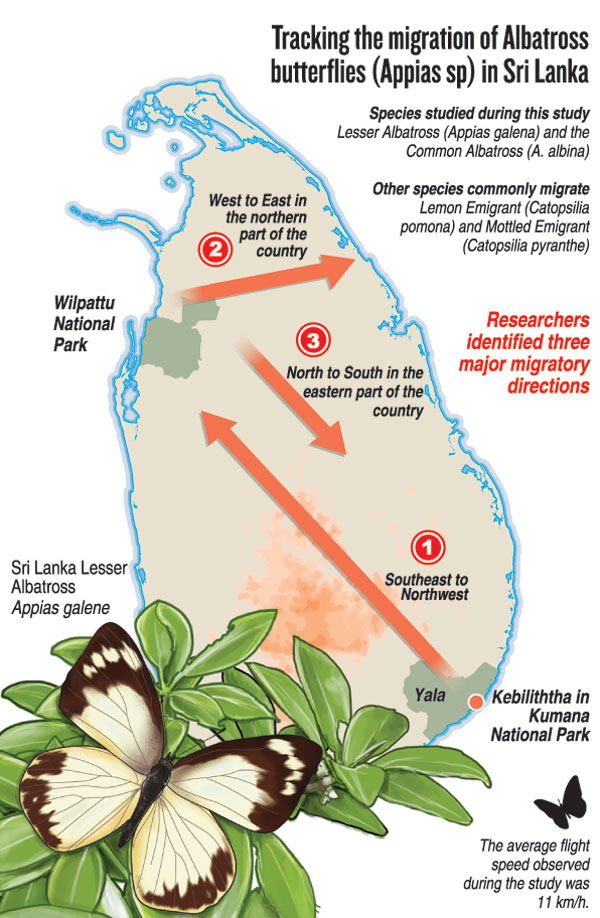News
Unveiling a butterfly mystery: Research sheds light on little-known migration
View(s):By Malaka Rodrigo
In the past, clouds of butterflies flying in one direction were a sight to behold. According to folklore, these butterflies were flying towards the holy mountain, Adam’s Peak (Sripada), to pay obeisance to Lord Buddha’s sacred footprint. This phenomenon gave rise to the commonly used name ‘Samanala Kanda’.
Whether these butterflies were actually flying towards Adam’s Peak or simply performing ad-hoc movements has long puzzled naturalists. To shed some light on this mystery, a group of butterfly enthusiasts conducted a coordinated study of butterfly movements across the country. Their findings were recently published in the scientific journal Taprobanica.


ALbatross butterly feeding on mud
Researchers observed the movements of two butterfly species, the Lesser Albatross (Appias galena) and the Common Albatross (A. albina), during the inter-monsoonal period from March to April 2023. Researchers conducted observations at 60 random locations to determine the starting points and directions of the migration. The results indicated that most Albatross butterflies migrated towards the northwest of the country.
“We first observed a large group of butterflies swarming over Talawakele and Kandy on March 6, 2023,” said Lakshman Kumara, secretary of the Butterfly Conservation and Research Group of Sri Lanka. “We immediately began gathering information from other locations across Sri Lanka.”
The butterfly enthusiasts observed the butterflies’ movements from March 6 to April 1, 2023, recording the direction of butterfly flight and the average number of butterflies passing each observation location per minute, Mr. Kumara told the Sunday Times.
After marking their observations on the map, three major migratory directions were identified; one from the southeast to northwest, the second from east to west in the northern part of the country, and the third from the north to south in the eastern part of the country.
Researchers also calculated the flight speed of the migrating butterflies by timing how long it took for 10 individual butterflies to travel 10 metres at each observation location. The average flight speed was 11 km/h.
The direct distance from Kumana National Park through the central mountains to Wilpattu National Park is 280 km. If the butterflies fly eight hours each day (from 8 a.m. to 4 p.m.) without stopping, they would travel 88 km per day. According to these findings, they could reach Wilpattu National Park within three days. However, accounting for stops for feeding and adverse weather conditions (e.g. headwinds), the migration from Kumana to Wilpattu is more likely to take four days or more, according to the researchers.
In addition, at Kebiliththa in Kumana National Park, several hundred Albatross butterflies were observed moving in a northwest direction. This suggests that Kumana National Park in the southeast could be a breeding location for these butterflies. “The Sunday Times exclusively reported on this phenomenon, requesting readers to report any notable butterfly movements to the researchers. This resulted in a good response, which significantly helped the study,” said Mr. Kumara with gratitude.
“Our findings differ from the traditionally common understanding and previous records that butterflies migrate towards Adam’s Peak,” says Prof. Kapila Dissanayake of Sabaragamuwa University. “It is possible that the species migrating towards ‘Samanala Kanda’ were different, and their population has now dwindled.”
“This research is only an important first step,” he told the Sunday Times. “We need to conduct more studies to establish the butterfly migration patterns before it is too late, as we are already losing this wonderful phenomenon of nature.”
“This migration is an essential part of the butterflies’ life cycle, allowing them to find optimal conditions for feeding and breeding,” says Prof. Dissanayake.”We still need to unravel many mysteries surrounding this migration, but it is generally believed that changes in weather patterns, such as the onset of the monsoon or dry season, can trigger it. The availability of food resources and breeding grounds also plays a critical role in triggering migration.”
“The butterfly migration can also be an important ecological event, contributing to the pollination of various plants,” says Rajika Gamage, an author of several butterfly guidebooks. “Traditionally, an array of butterflies formed large clouds that migrated, but currently, there is a drastic reduction in butterfly numbers and the species involved,” Mr. Gamage told the Sunday Times.
“In addition to the Albatross butterfly species, the Lemon Emigrant (Catopsilia pomona) still continues the legacy of migration to some extent,” says Mr. Gamage. “However, another butterfly species, the Mottle Emigrant, has seen a drastic reduction in numbers. Butterfly enthusiasts believe that the loss of their host plants is a major contributing factor.”
“The Mottle Emigrant typically lays its eggs on ‘thora’ plants (Cassia tora and similar species), which were once commonly found growing wild along roadsides and in empty spaces. Now, invasive plants like Guinea grass (Megathyrsus maximus) have taken over these open areas. The lack of host plants is likely contributing to the decline of this butterfly species,” Mr. Gamage pointed out.
“The Albatross butterflies lay their eggs on ‘weera trees,’ which grow tall, while the other emigrant butterflies lay their eggs on ehala trees. These trees are still plentiful, as they are commonly used in landscaping,” Mr. Gamage added.
“During migration, butterflies also rely on nectar plants for survival. In the past, there were many wildflowers available, but these have been replaced by invasive species. For example, lanthana (gandapana in Sinhala) is now extensively used by butterflies as a nectar source. Nowadays, if you analyse butterfly photos, about 70 out of 100 will show butterflies on such invasive flowers,” Mr. Gamage points out.
“Home gardens can play a vital role in supporting butterflies,” Mr. Gamage said, urging people to get to know the butterflies commonly seen in their areas and to plant relevant host plants where butterflies could lay eggs, as well as plants with nectar-bearing flowers.

The best way to say that you found the home of your dreams is by finding it on Hitad.lk. We have listings for apartments for sale or rent in Sri Lanka, no matter what locale you're looking for! Whether you live in Colombo, Galle, Kandy, Matara, Jaffna and more - we've got them all!

